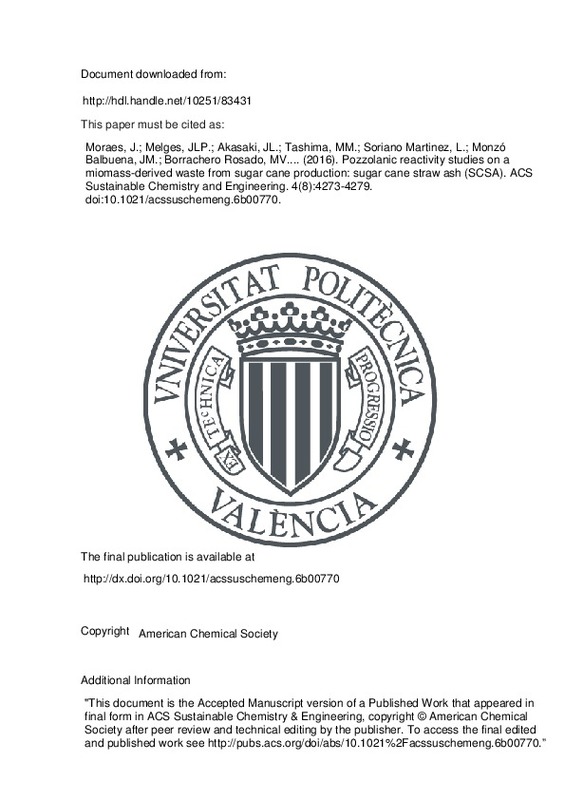Moraes, J.; Melges, JLP.; Akasaki, JL.; Tashima, MM.; Soriano Martínez, L.; Monzó Balbuena, JM.; Borrachero Rosado, MV.... (2016). Pozzolanic reactivity studies on a miomass-derived waste from sugar cane production: sugar cane straw ash (SCSA). ACS Sustainable Chemistry and Engineering. 4(8):4273-4279. https://doi.org/10.1021/acssuschemeng.6b00770
Por favor, use este identificador para citar o enlazar este ítem: http://hdl.handle.net/10251/83431
|
Título:
|
Pozzolanic reactivity studies on a miomass-derived waste from sugar cane production: sugar cane straw ash (SCSA)
|
|
Autor:
|
Moraes, J.C.B
Melges, J. L. P.
Akasaki, Jorge Luis
Tashima, M. M.

 Soriano Martínez, Lourdes
Soriano Martínez, Lourdes

 Monzó Balbuena, José Mª
Monzó Balbuena, José Mª

 Borrachero Rosado, María Victoria
Borrachero Rosado, María Victoria

 Paya Bernabeu, Jorge Juan
Paya Bernabeu, Jorge Juan
|
|
Entidad UPV:
|
Universitat Politècnica de València. Escuela Técnica Superior de Ingenieros de Caminos, Canales y Puertos - Escola Tècnica Superior d'Enginyers de Camins, Canals i Ports
Universitat Politècnica de València. Instituto de Ciencia y Tecnología del Hormigón - Institut de Ciència i Tecnologia del Formigó
|
|
Fecha difusión:
|
|
|
Resumen:
|
Biomass has gained in importance as an energy source in recent years. One of the crops that presents interesting opportunities with regard to biomass is sugar cane. In Brazil, sugar cane production is increasing for alcohol ...[+]
Biomass has gained in importance as an energy source in recent years. One of the crops that presents interesting opportunities with regard to biomass is sugar cane. In Brazil, sugar cane production is increasing for alcohol and sugar manufacture. Some by-products, such as sugar cane straw, also are obtained during harvesting. Due the calorific value of the sugar cane straw, its use as biomass is increasing. After the straw is burned to produce energy, an ash is obtained: sugar cane straw ash (SCSA). This waste needs an appropriate destination and, since the recent publication of successful studies using biomass derived-ashes as pozzolanic material, the present study aimed to assess the pozzolanic reactivity of sugar cane straw ash. The pozzolanic activity was assessed using a new and simple recently proposed method: evaluation of the electrical conductivity of calcium hydroxide (CH) and pozzolan suspensions, in which solid CH is initially present. These results were compared to those of two other well-established techniques: Fourier transformed infrared spectroscopy and thermogravimetric analysis. The evaluation by all three techniques is similar and shows that sugar cane straw ash is a good pozzolanic material: high lime fixation values for CH:SCSA mixes were determined by thermogravimetric analysis and unsaturation respect to CH in 3.5:6.5 CH:SCSA suspension was achieved at 60ºC. According to this behaviour, a bright future for SCSA as a replacement for Portland cement is expected.
[-]
|
|
Palabras clave:
|
Agro-industry residue
,
Pozzolan
,
Hydrated lime
,
Fourier-transformed infrared
spectroscopy
,
Thermogravimetric analysis
,
Electrical conductivity measurement
,
Scanning
electron microscopy,
,
Electron Microscopy Service of the UPV
|
|
Derechos de uso:
|
Reserva de todos los derechos
|
|
Fuente:
|
ACS Sustainable Chemistry and Engineering. (issn:
2168-0485
)
|
|
DOI:
|
10.1021/acssuschemeng.6b00770
|
|
Editorial:
|
American Chemical Society
|
|
Versión del editor:
|
http://dx.doi.org/10.1021/acssuschemeng.6b00770
|
|
Código del Proyecto:
|
info:eu-repo/grantAgreement/CNPq//401724%2F2013-1/
info:eu-repo/grantAgreement/ME//PHB2011-0016-PC/ES/NUEVOS CONGLOMERANTES BASADOS EN LA ACTIVACION ALCALINA DE CENIZAS DE BAGAZO Y DE HOJA DE CAÑA DE AZUCAR. /
|
|
Descripción:
|
"This document is the Accepted Manuscript version of a Published Work that appeared in final form in ACS Sustainable Chemistry & Engineering, copyright © American Chemical Society after peer review and technical editing by the publisher. To access the final edited and published work see http://pubs.acs.org/doi/abs/10.1021%2Facssuschemeng.6b00770.”
|
|
Agradecimientos:
|
We thank CNPq (processo no. 401724/2013-1) and the "Ministerio de Education, Cultura y Deporte" of Spain ("Cooperacion Interuniversitaria" program with Brazil PHB-2011-0016-PC). Thanks are also due to the Electron Microscopy ...[+]
We thank CNPq (processo no. 401724/2013-1) and the "Ministerio de Education, Cultura y Deporte" of Spain ("Cooperacion Interuniversitaria" program with Brazil PHB-2011-0016-PC). Thanks are also due to the Electron Microscopy Service of the Universitat Politecnica de Valencia
[-]
|
|
Tipo:
|
Artículo
|







![[Cerrado]](/themes/UPV/images/candado.png)


